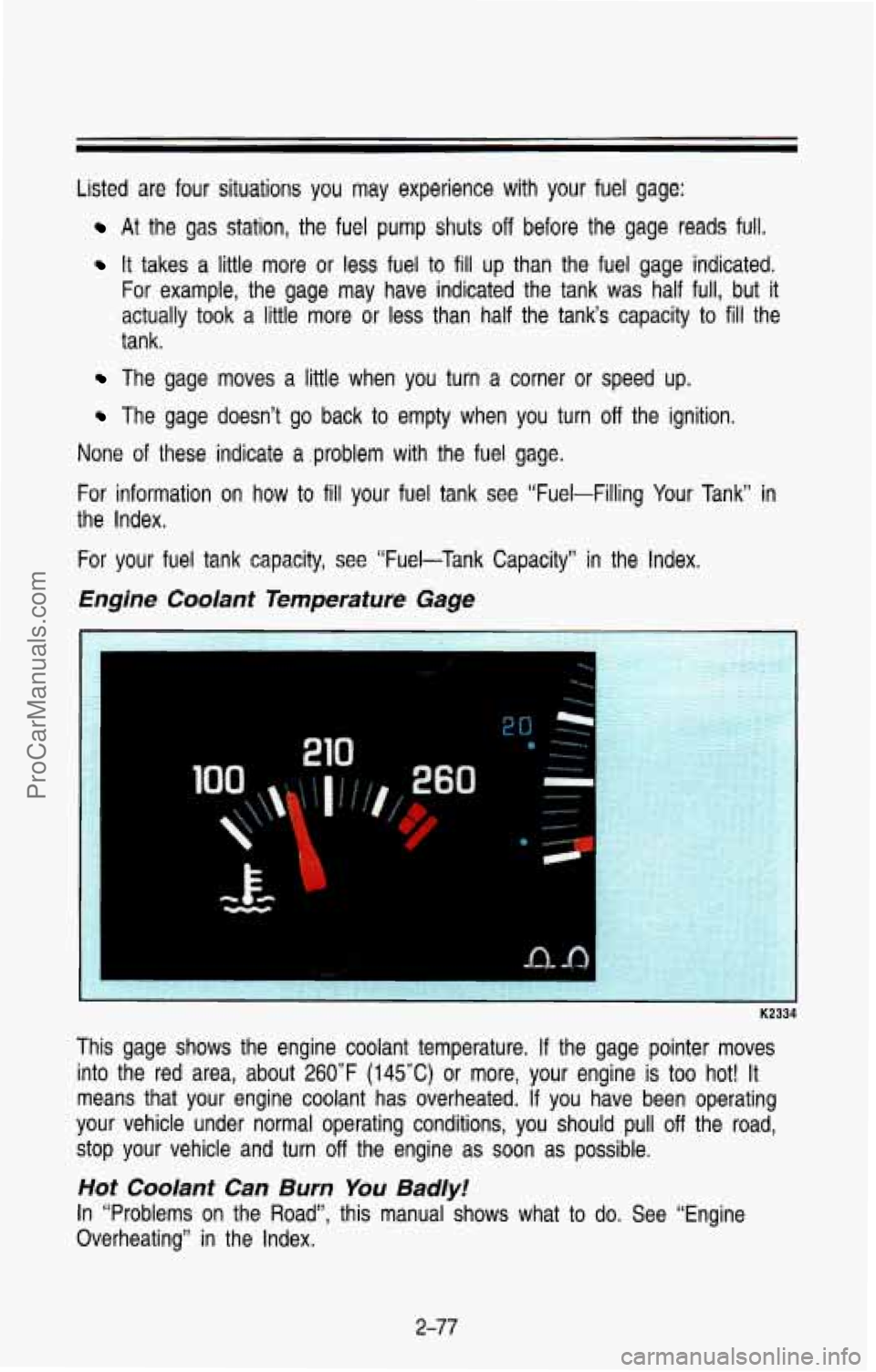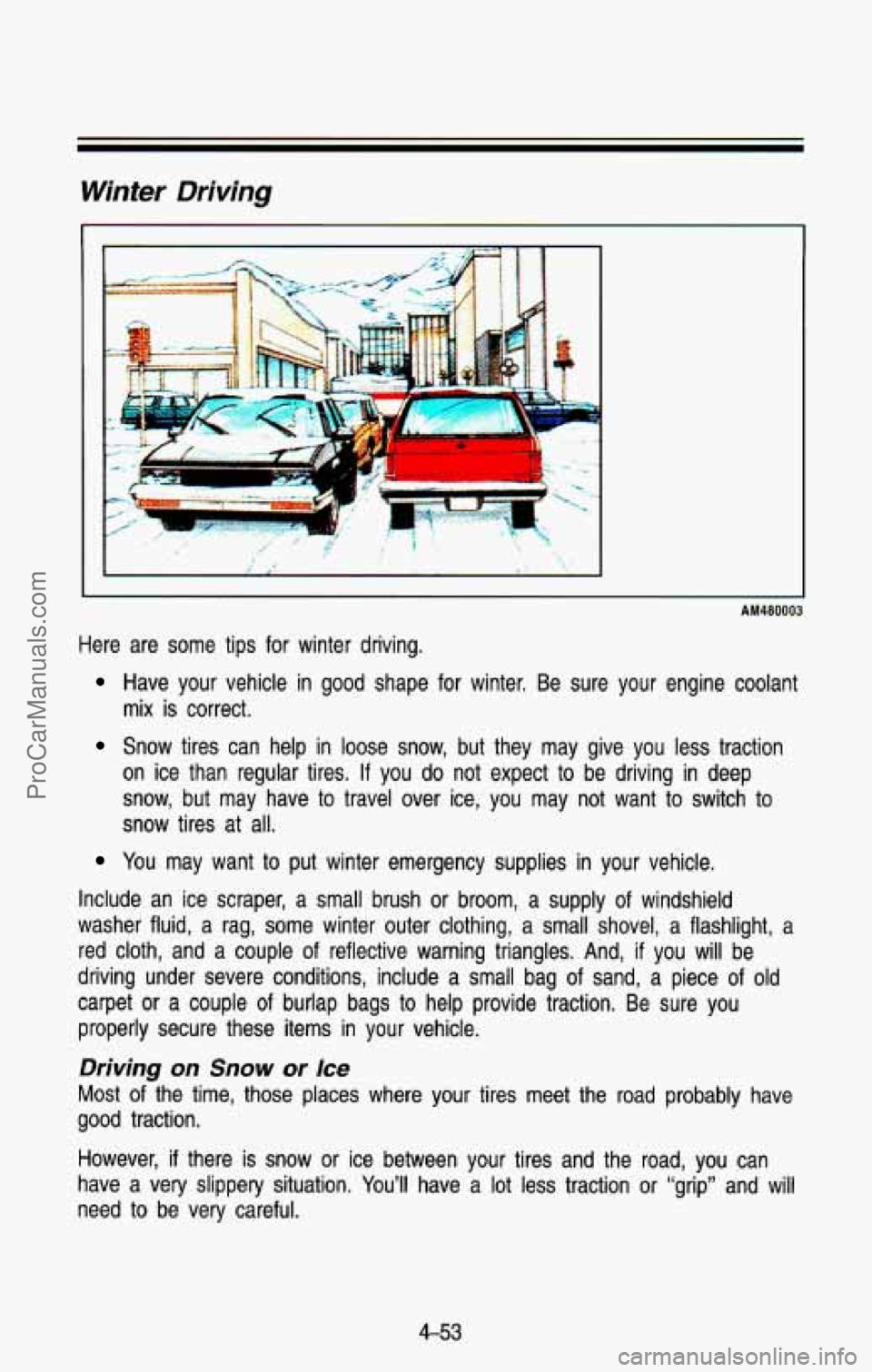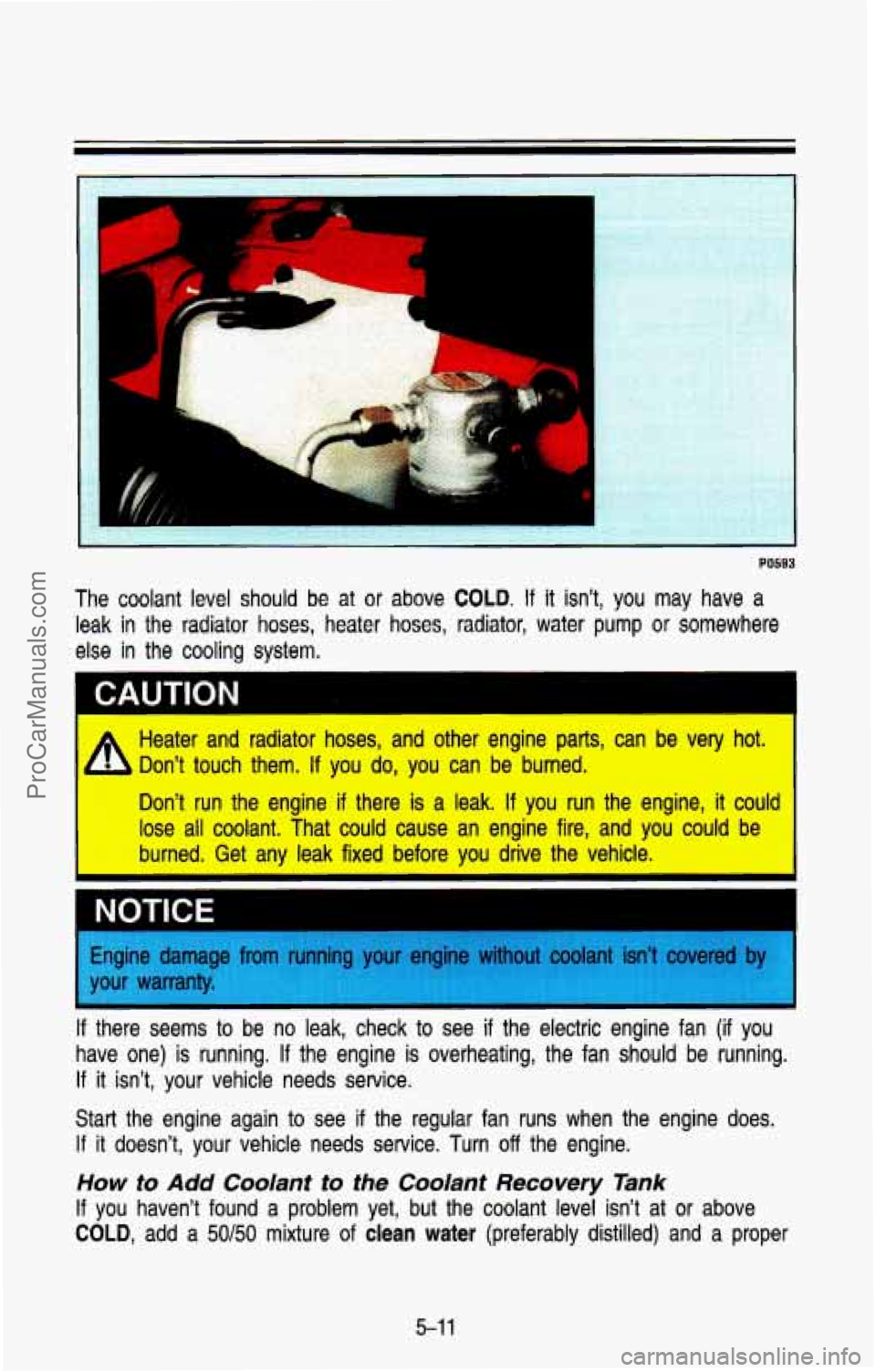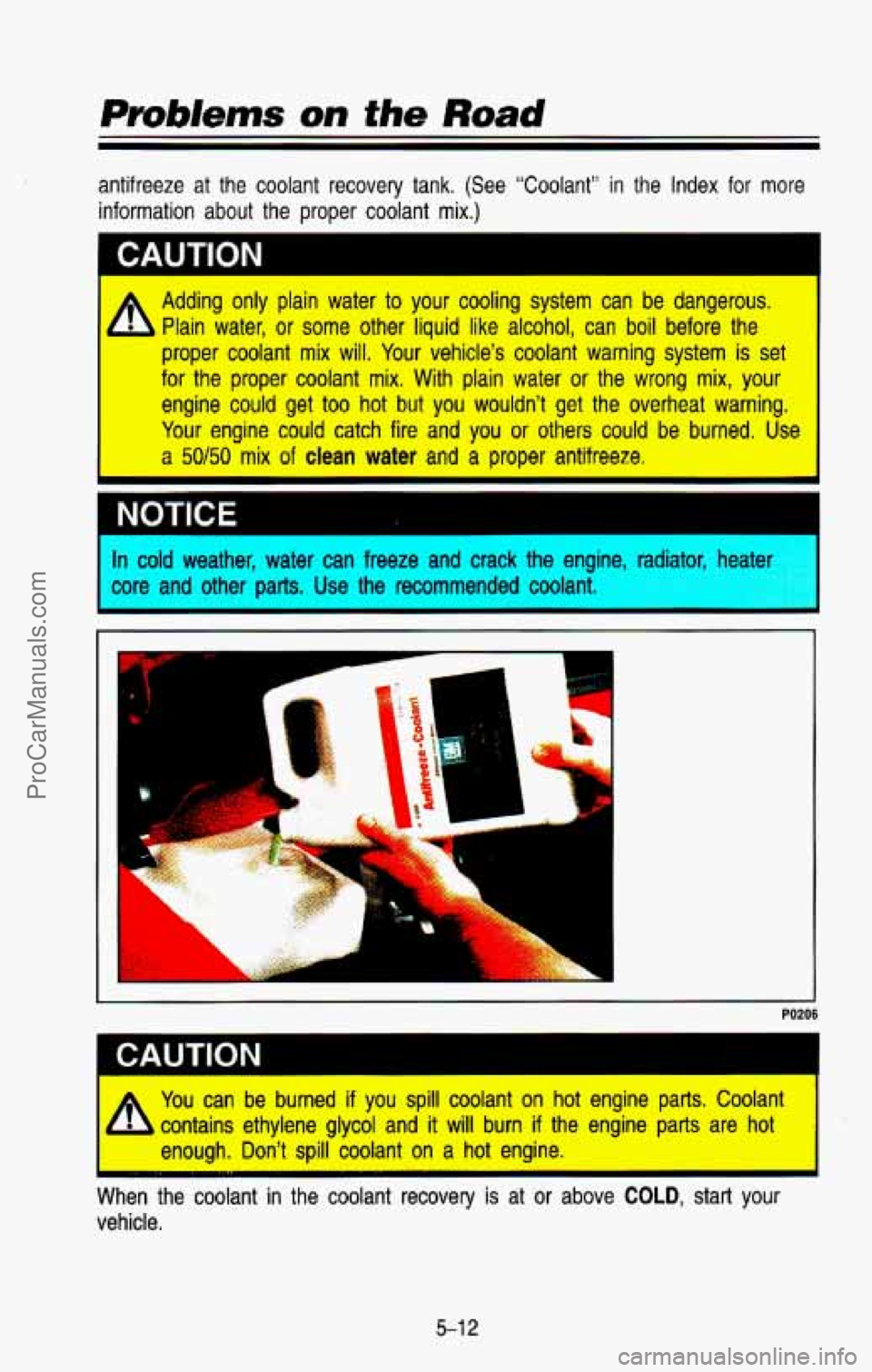Page 13 of 386
These symbols are used on warning and indicator lights.
Engine Coolant Temperature
BRAKE
Brake
I-,
Battery Charging
System Fuel
ANTI-
LOCK 1
1 4 Wheel
Anti-Lock
RELEASE
Parking Brake
Release
I
Engine Oil
Pressure
I
I SHIFT
1
Shift Light
Here are some other symbols you may see:
Fuse Hood Release Lighter Horn
PO597
0-6
ProCarManuals.com
Page 140 of 386

Listed are four situations you may experience with your fuel gage:
At the gas station, the fuel pump shuts off before the gage reads full.
It takes a little more or less fuel to fill up than the fuel gage indicated.
For example, the gage may have indicated the tank
was half full, but it
actually took a little more or less than half the tank’s capacity to
fill the
tank.
The gage moves a little when you turn a corner or speed up. \
The gage doesn’t go back to empty when you turn off the ignition.
None
of these indicate a ,problem with the fuel gage.
For information on how to
fill your fuel tank see “Fuel-Filling Your Tank” in
the Index.
For your fuel tank capacity, see “Fuel-Tank Capacity”
in the Index.
Engine Coolant Temperature Gage
260
This gage shows the engine coolant temperature. If the gage pointer moves
into the red area, about 260°F
(145°C) or more, your engine is too hot! It
means that your engine coolant has overheated.
If you have been operating
your vehicle under normal operating conditions, you should pull \
off the road,
stop your vehicle and turn
off the engine as soon as possible.
Hot Coolant Can Burn You Badly!
In “Problems on the Road”, this manual shows what to do. See “Engine
Overheating” in the Index.
2-77
ProCarManuals.com
Page 150 of 386
Heater Output
Optional Engine Block Heater
If your engine is equipped with an optional engine block heater, you can use
it during initial start-up in cold weather (20"F,
-8OC, or lower) to help heat the
passenger compartment faster. Because an engine block heater war\
ms the
engine coolant, your vehicle's heating system can provide some \
heat as soon
as you start the engine.
The use of an engine block heater also reduces the time it takes for the
engine to reach normal operating temperature, and shortens the time it takes
the heater to reach full output. For more information, See "Engine Block
Heater" in the Index.
Electronic Heating/Air Conditioning System
Function Display
I ................... ...........I
K2:
If your vehicle has air conditioning, your heating/air conditioning \
system will
look like this.
When you first turn on your vehicle's air conditioning, open the windows
to
clear the vehicle of hot air.
3-5
ProCarManuals.com
Page 220 of 386

Winter Driving
r
AM480003
Here are some tips for winter driving.
Have your vehicle in good shape for winter. Be sure your engi\
ne coolant
mix is correct.
Snow tires can help in loose snow, but they may give you les\
s traction
on ice than regular tires.
If you do not expect to be driving in deep
snow, but may have to travel over ice, you may not want
to switch to
snow tires at all.
You may want to put winter emergency supplies in your vehicle.
Include
an ice scraper, a small brush or broom, a supply of windshield
washer fluid, a rag, some winter outer clothing, a small shovel, a flashlight, a
red cloth, and a couple of reflective warning triangles. And, if you will be
driiing under severe conditions, include a small bag of sand, a piece of
old
carpet or a couple of burlap bags to help provide traction. Be sure you
properly secure these items in your vehicle.
Driving on Snow or Ice
Most of the time, those places where your tires meet the road probably\
have
good traction.
However,
if there is snow or ice between your tires and the road, you can
have a very slippery situation. You’ll have a lot less traction or “grip” and
will
need to be very careful.
4-53
ProCarManuals.com
Page 239 of 386
Pmbkms on the Road
If your vehicle has the four-wheel-drive option and the transfer case is
engaged,
a dolly must be used under the rear wheels when towing from the
front.
Engine Overheating
You will find a coolant temperature gage on your vehicle instrument panel,
If Steam Is Coming From Your Engine:
I
‘i Steam from an overheated engine can bum you badly, even if you
just open the hood. Stay away from the engine if you see or hear
steam coming from it. Just turn it off and get everyone away from
the vehide until it cools down. Wait until there is no sign of steam or
coalant before opening the hood.
If you keep driving when your engine is overheated, the liquids in it
can catch fire. You or others could be badly burned. Stop your
engine if it overheats, and get out of the vehicle until the engine is
Cool.
you keep driving with no coolant, your
costly repairs would not be covered
by
your warranty.
5-8
ProCarManuals.com
Page 241 of 386
Cooling System
.i
I
PO21 0
When you decide it's safe to lift the hood, here's what you'l\
l see:
A. Coolant recovery tank
B. Radiator pressure cap
C. Engine fan
A
An electric fan under the hood can start up even when the engine is
not running and can injure you. Keep hands, clothing, and tools
away from any underhood
electric fan.
CAUTION
If the coolant inside the coolant recovery tank or surge tank is \
boiling, don't
do anything else until it cools down.
5-1 0
ProCarManuals.com
Page 242 of 386

The coolant level should be at or above COLD. If it isn’t, you may have a
leak in the radiator hoses, heater hoses, radiator, water pump or somewhere
else in the cooling system.
CAUTION
A
Heater and radiator hoses, and other engine parts, can be very\
hot.
Don’t touch them. If you
do, you can be burned.
Don’t run the engine
if there is a leak. If you run the engine, 1‘ it coulc
lose all coolant. That could cause an engine fire, and you could
be
I burned. Get any leak fixed before you drive the vehicle.
I
If there seems to be no leak, check to see if the electric engine fan (if you
have one) is running. If the engine is overheating, the fan \
should be running.
If
it isn’t, your vehicle needs service.
Start the engine again to see
if the regular fan runs when the engine does.
If
it doesn’t, your vehicle needs service. Turn off the engine.
How to Add Coolant to the Coolant Recovery Tank
If you haven’t found a problem yet, but the coolant level \
isn’t at or above
COLD, add a 50150 mixture of clean water (preferably distilled) and a proper
5-1 1
ProCarManuals.com
Page 243 of 386

antifreeze at the coolant recovery tank. (See “Coolant” i\
n the Index for more information about the proper coolant mix.)
Adding only plain water to your cooling system can be dangerou\
s. Plain water,
or some other liquid like alcohol, can boil before the
proper coolant mix will. Your vehicle’s coolant warning system is set
for the proper coolant mix. With plain water
or the wrong mix, your
engine
could get too hot but you wouldn’t get the overheat warning.
Your engine could catch fire and you or others could be burned. Use
a 50150 mix of clean water and a proper antifreeze. I I
NOTICE I
In cold weather, water can freeze and crack the engine. radiator, heater
I core and other parts. Use the recommended coolant.
1
1 ::.
L.
k’
II
PO206
CAUTION
- = -
You can be burned if you spill coolant on hot engine parts. Coolant
contains ethylene glycol
and it will burn if the engine parts are hot
enough. Don’t spill coolant on
a hot engine.
When the coolant in the coolant recovery
is at or above COLD, start your
vehicle.
5-1 2
ProCarManuals.com